|
Grenada
the spice of the Caribbean Spring 2007 |
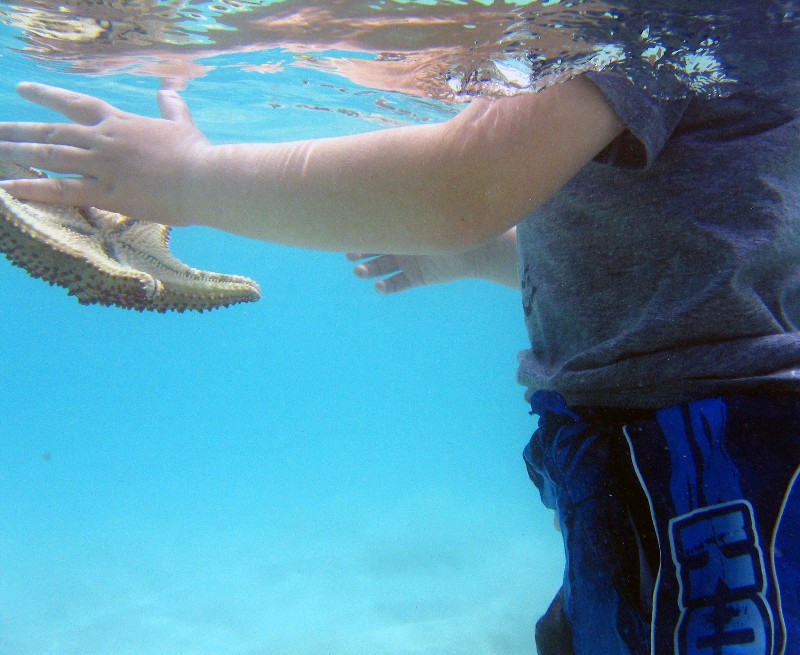 |
Sticky starfish.
Sticky starfish.
|
||
| May28
- June 3, 2007 |
On
Monday, it was swim, swim, swim time! First thing, we headed out
at Grand Anse Beach, frolicking in the sea. 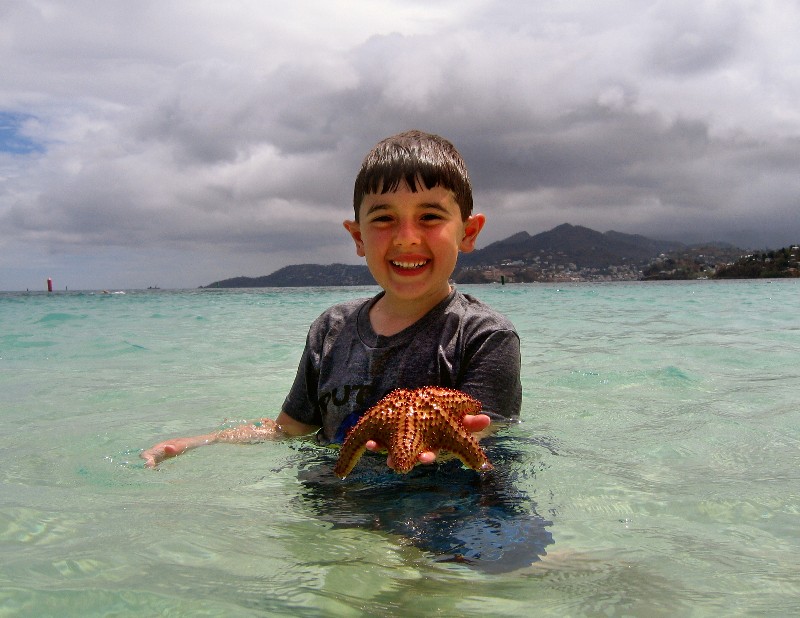 Jeffrey and friend. 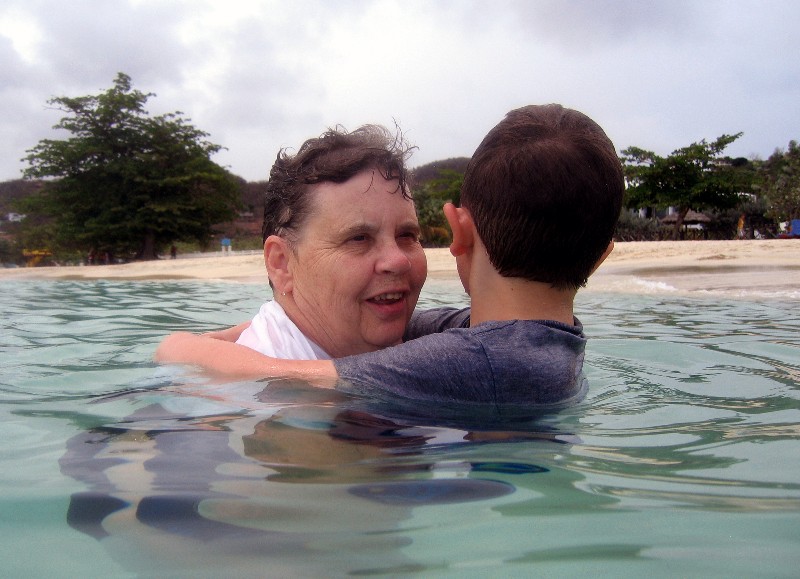 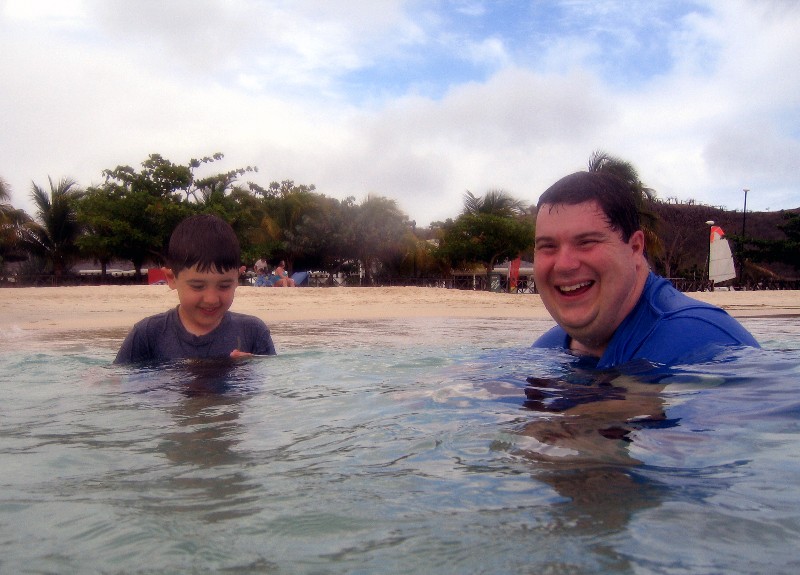 Jeffrey and Grandma. Jeffrey and Dad. After the sea, we ate lunch and played a rousing game of shuffleboard. Peter then joined us and we jumped into the Coyaba's pool. 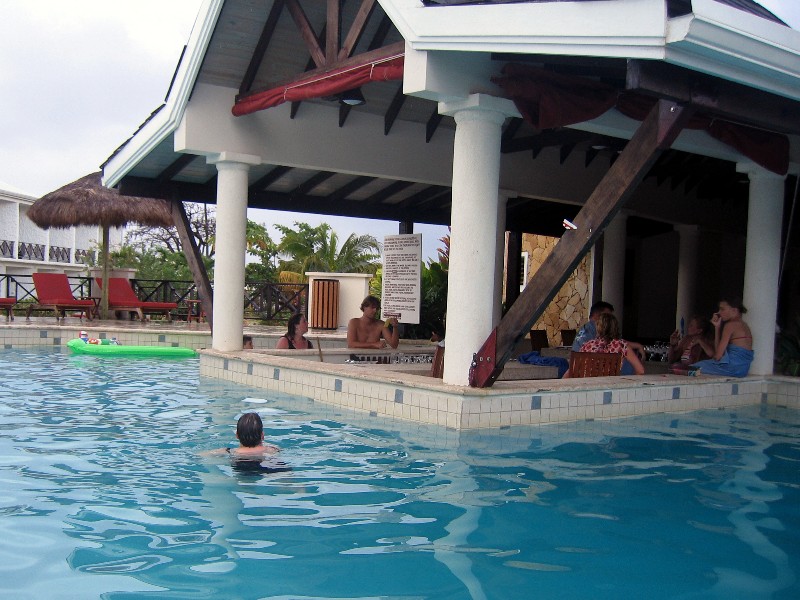 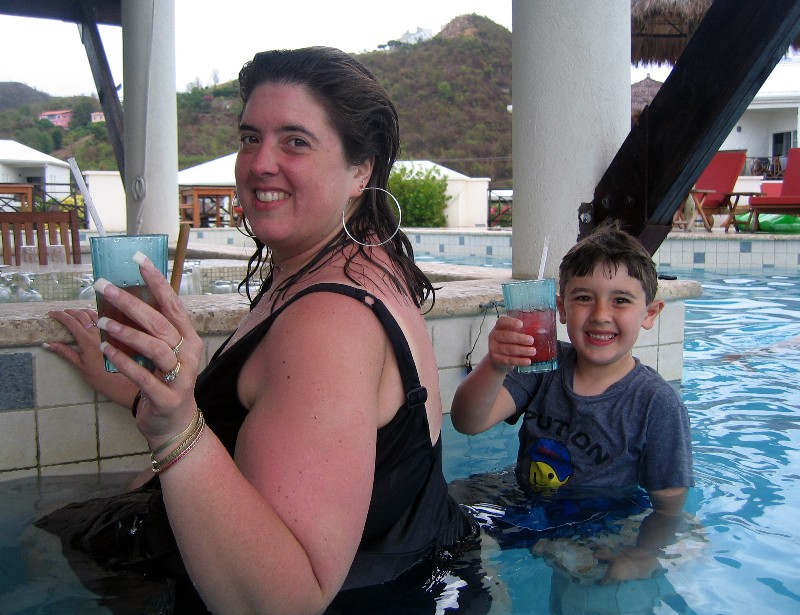 Drinks at the Coyaba poolside bar.  Underwater Peter.  And then came the rain. Sometimes it's hard to know how to have fun when it's raining. But that soon passes and silliness takes over... 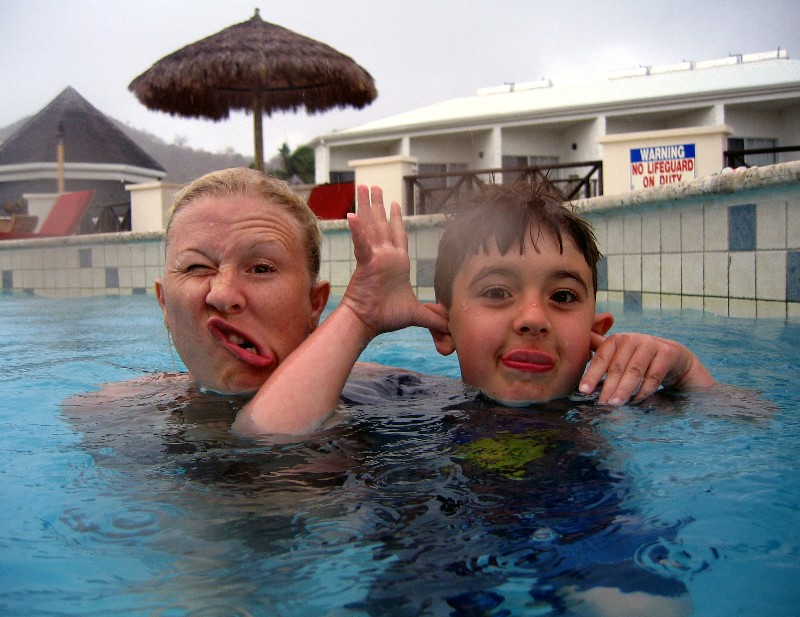 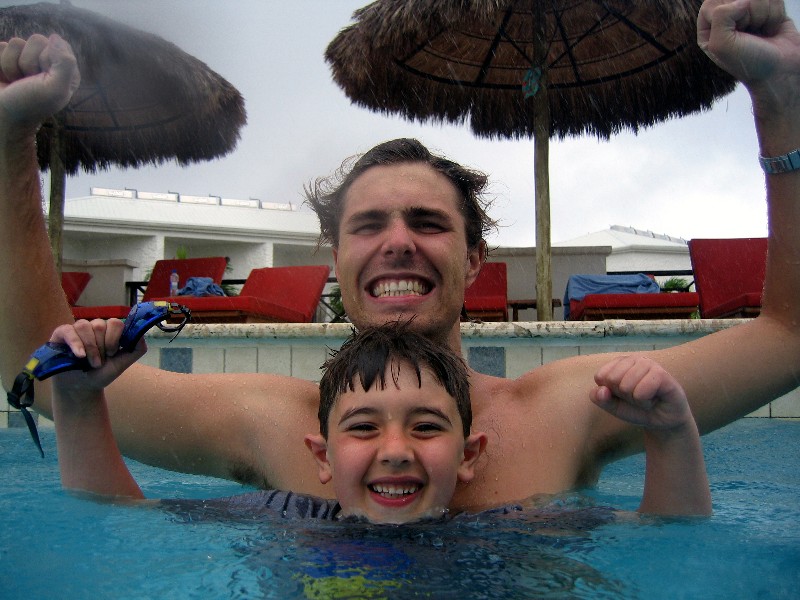 It was raining so hard when we got home that Peter wore his snorkel to help him brave the downpour! 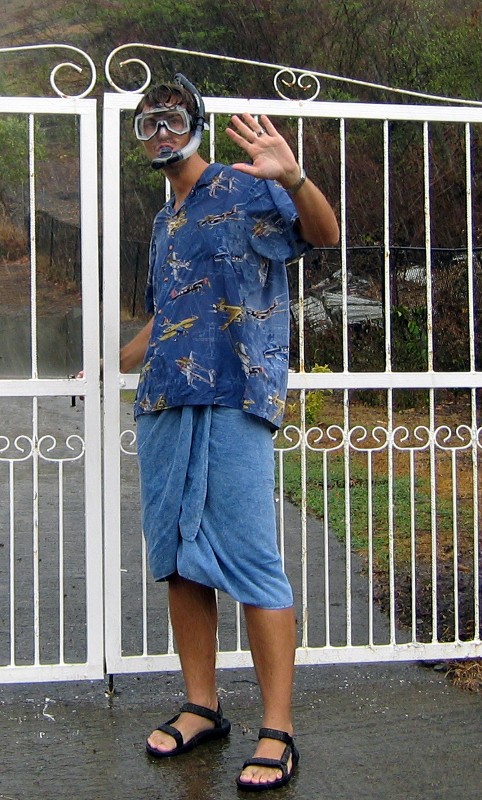 In the evening, the family came over to the house for some Go Fish and home cookin'. 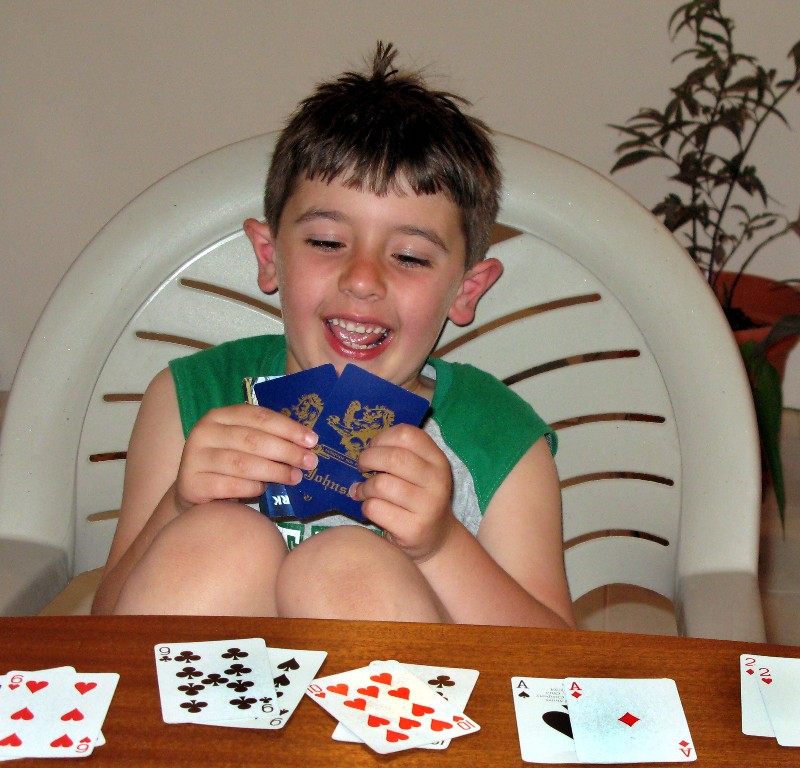 Jeffrey was the hands-down card shark. 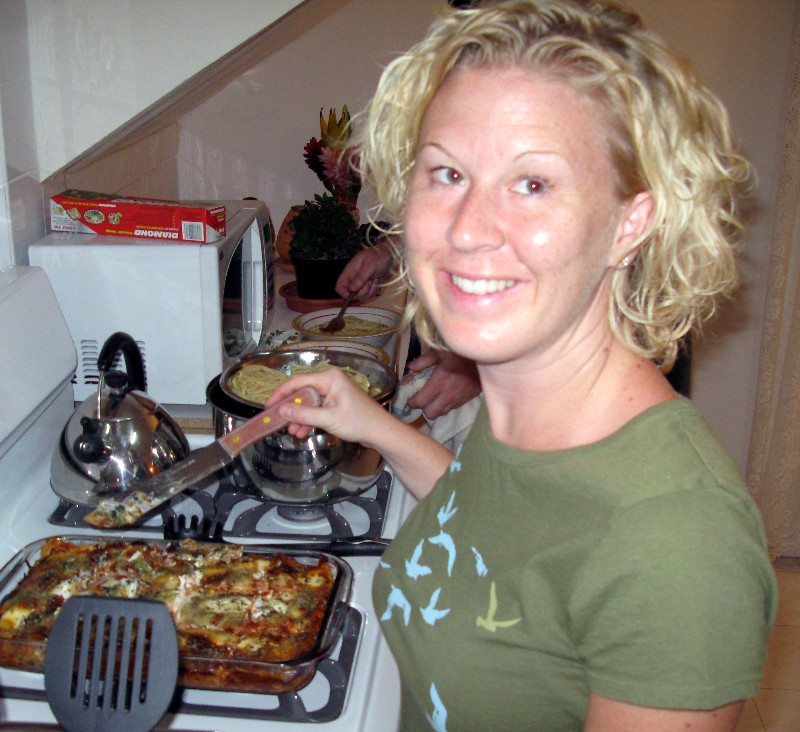 Mmmmm. Lasagna. |
| We
made the most of Tuesday morning, the family's day of departure. Heather and Nancy
went out for an early morning walk. A canine friend accompanied
us for the journey down the beach. After an brief interruption of
rain, we came across some local fishermen (seen in the photo below,)
who had just hauled in a catch of bait fish.
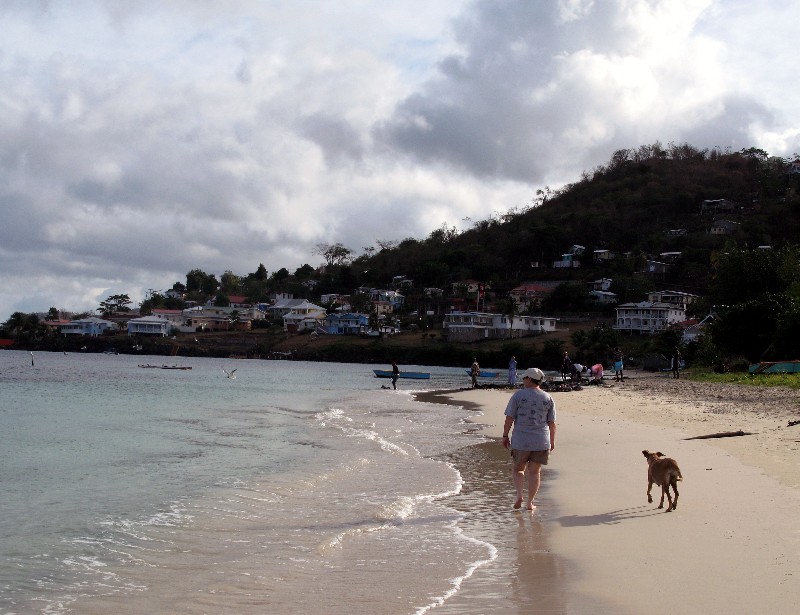 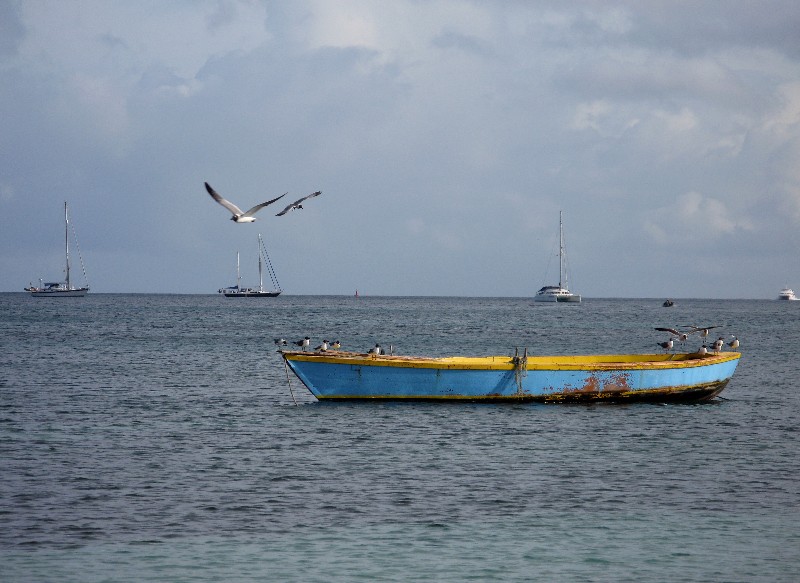 After breakfast, we
checked out some snorkel gear and headed to the water. Before we
were able to even take the few steps from the dive shop to the beach
and get the equipment on, the weather changed from periodic showers to
all-out downpour. Well, rain never stopped this family from
frolicking in sea!
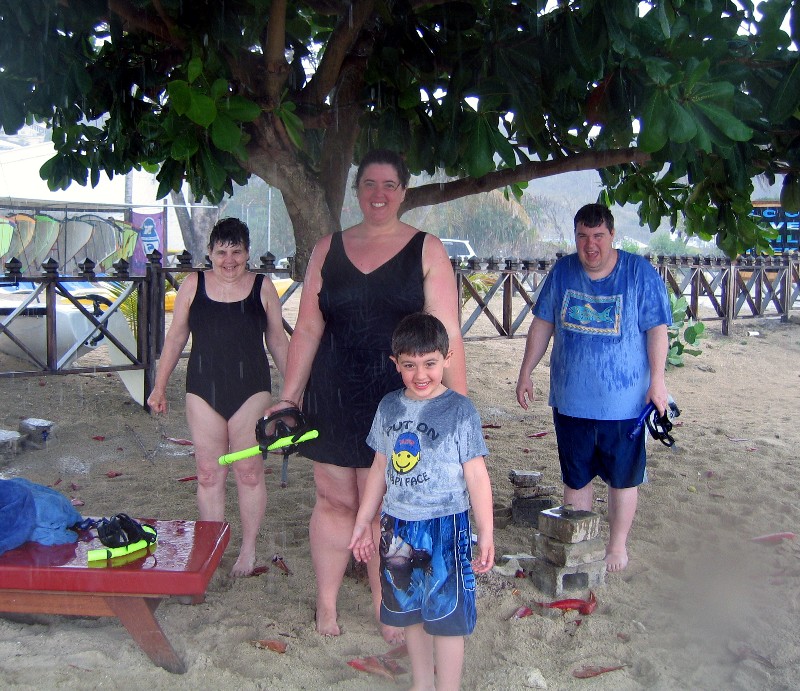 Rain? What rain? 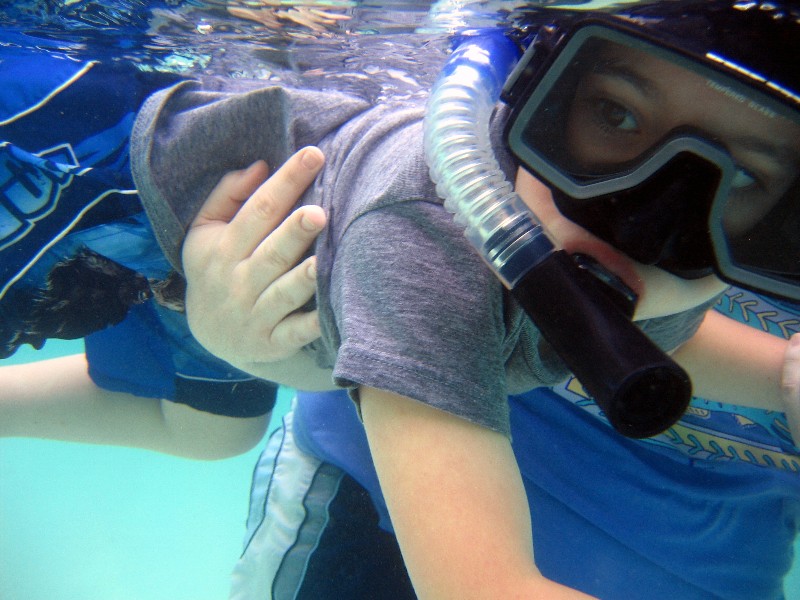 Dad helps Jeffrey feel comfortable. 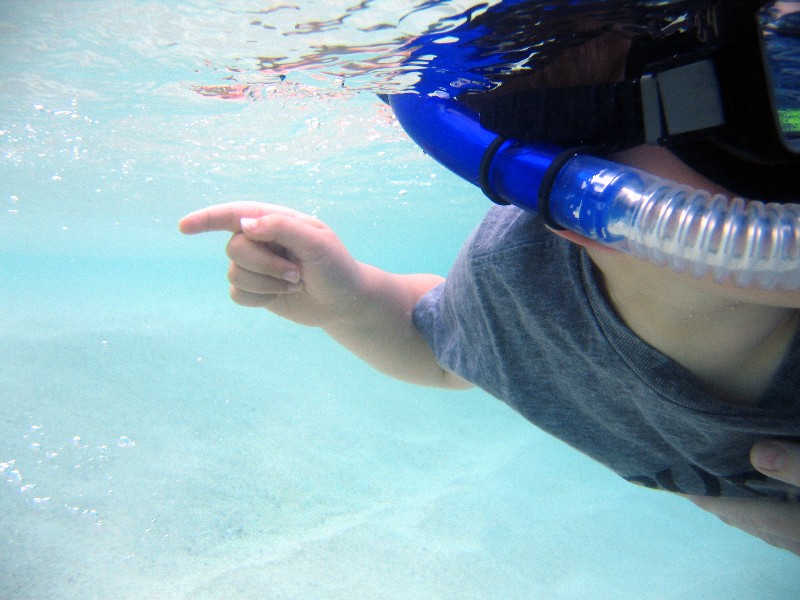 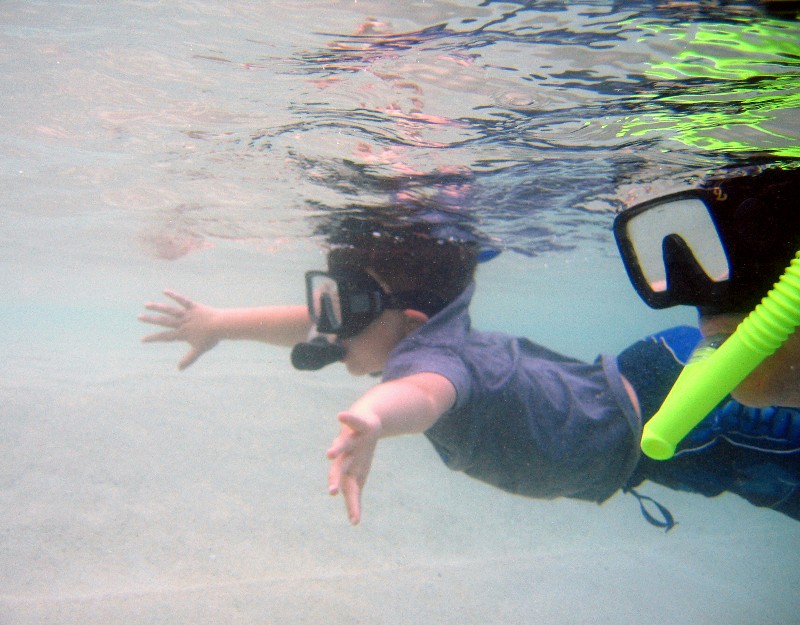 Jeffrey sees a fish...and he's OFF! 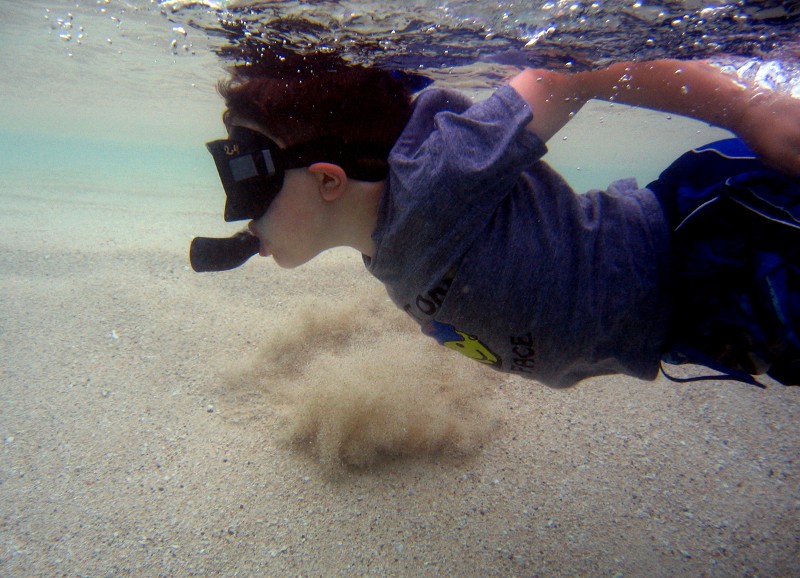 Pretty soon, no one could keep up with him! 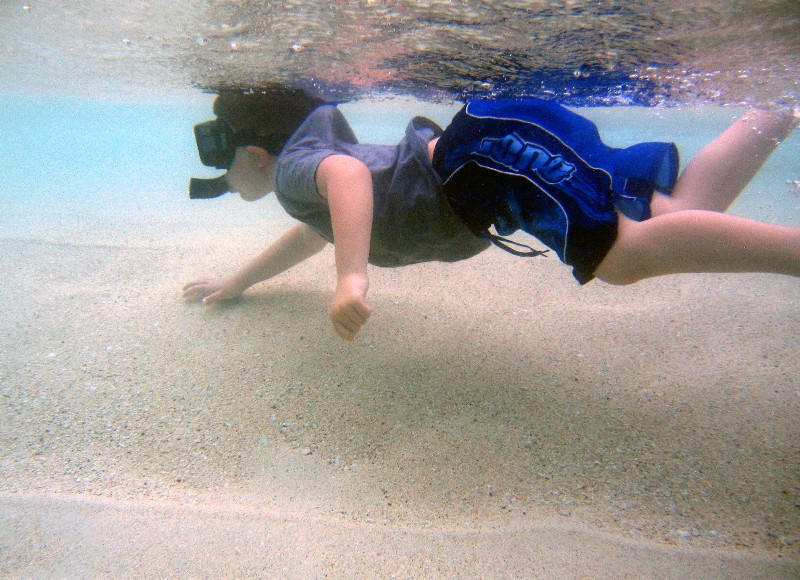 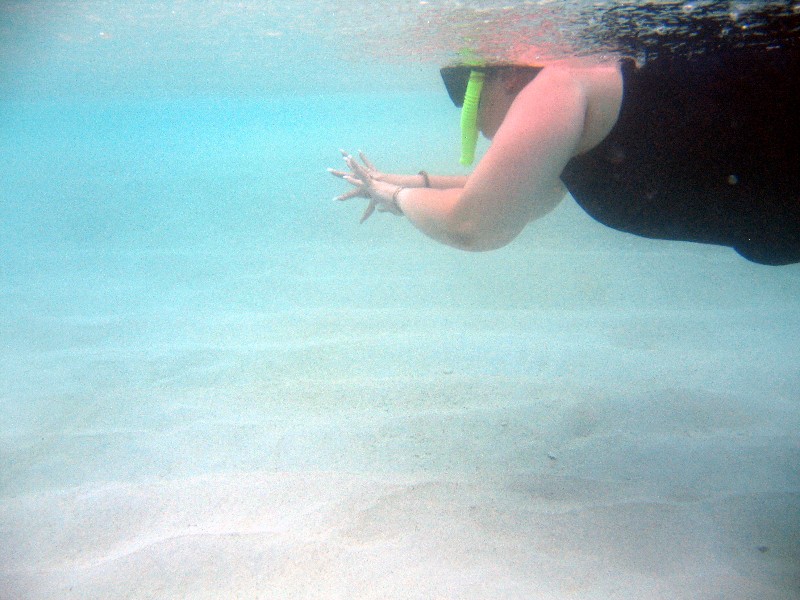 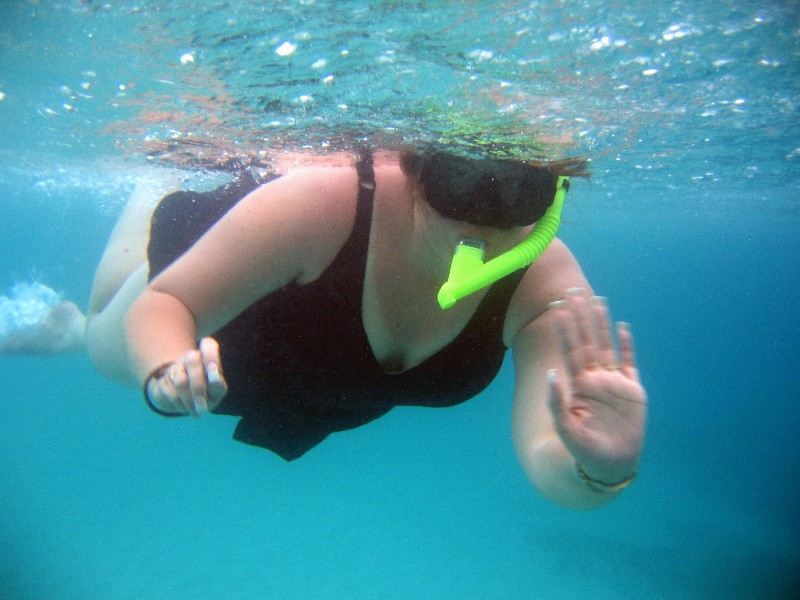 Go Jen! 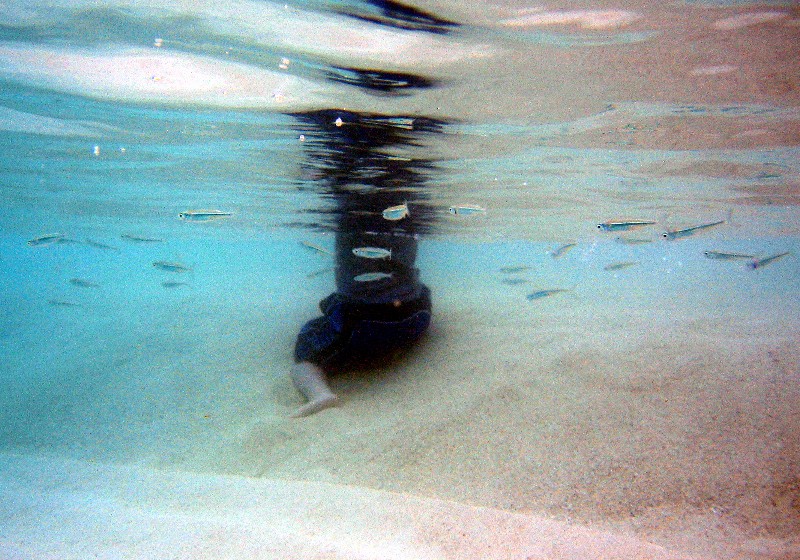 Jeffrey takes a break...and the fish come to check him out! 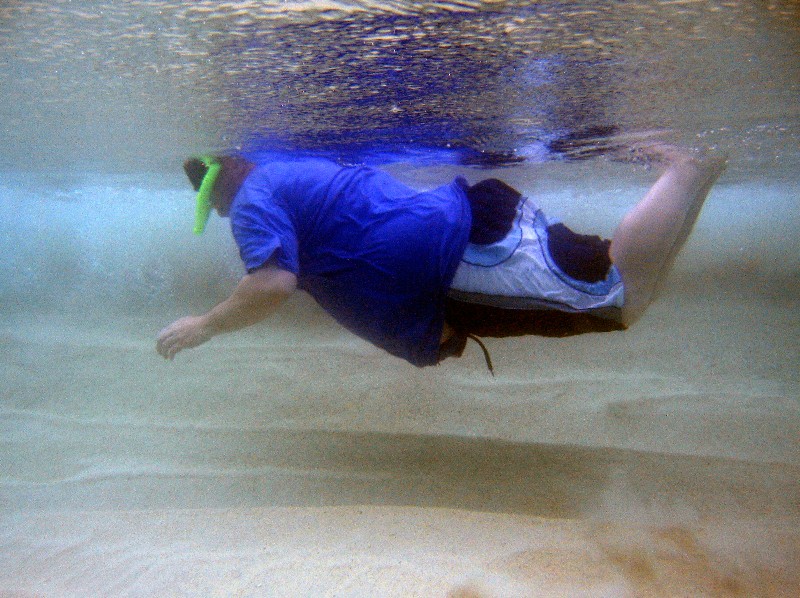  Although we didn't have perfect conditions, everyone was happy to see a few fish finally! 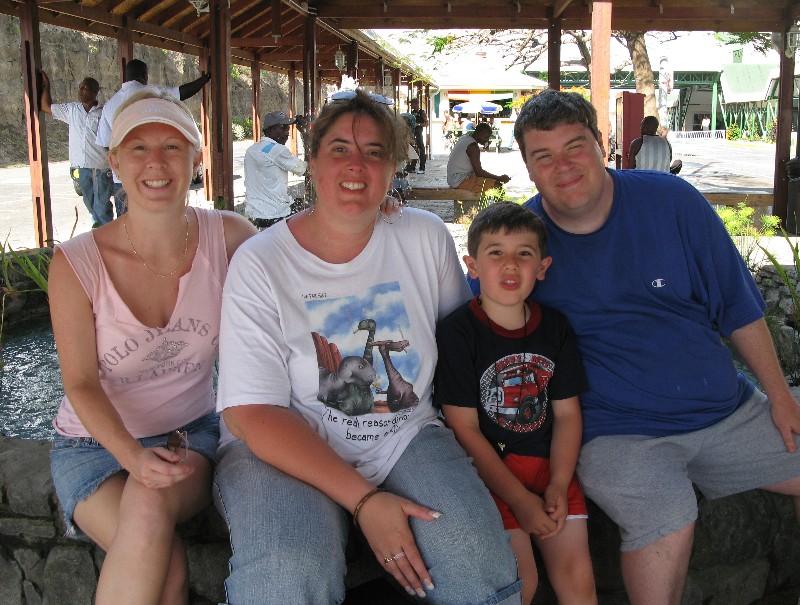 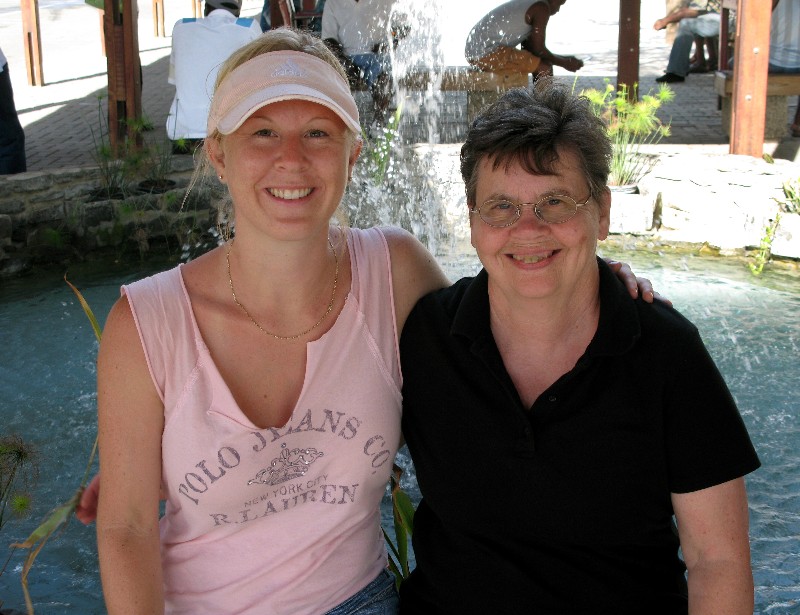 Airport good-byes. We were so glad to show my family our island home! |
This
week, we bid adieu to Jonathan and Manny: bound for the U.S. weeks
ahead of time. The SOS group is getting cozier by the week!
We all had pizza at Jonathan's favorite dinner haunt: Prickly Bay
Marina. Peter, Ave, Josh, Johnny, Sarah, Jonathan, and Britney. 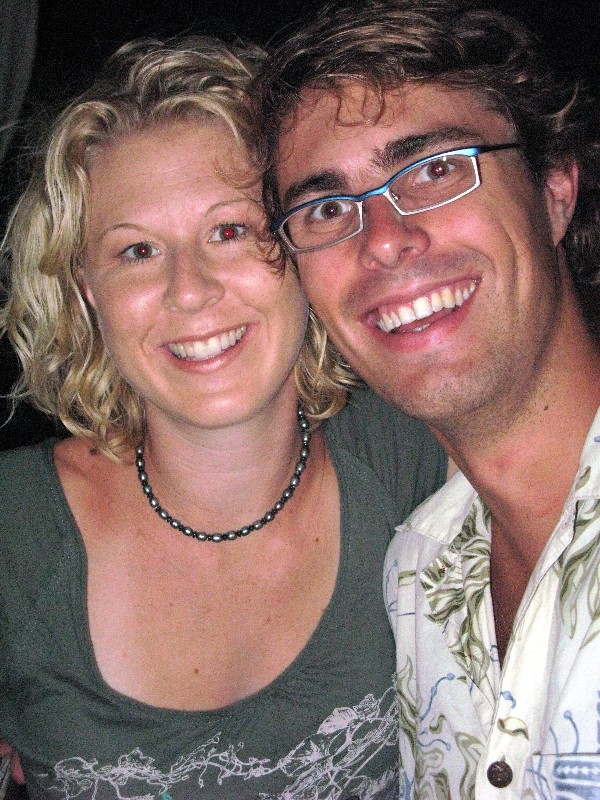 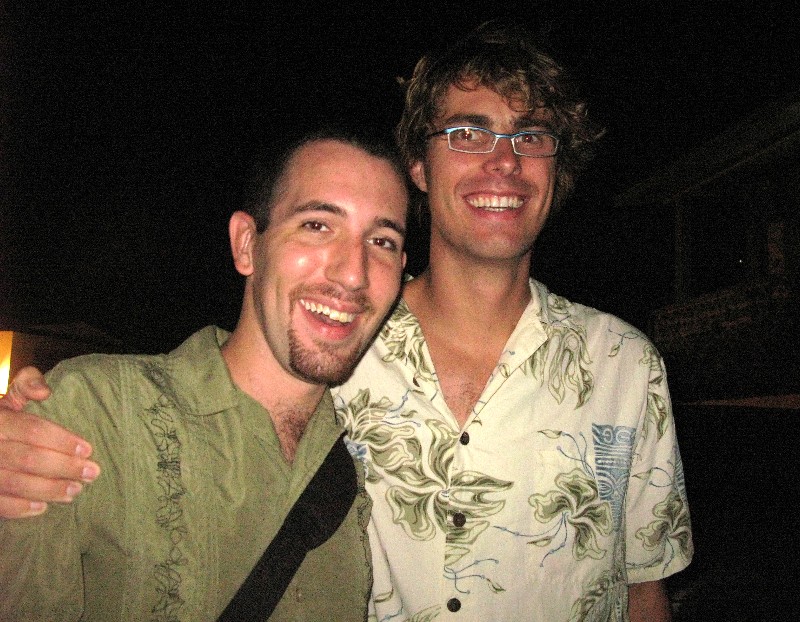 H&P The Josh & Peter. 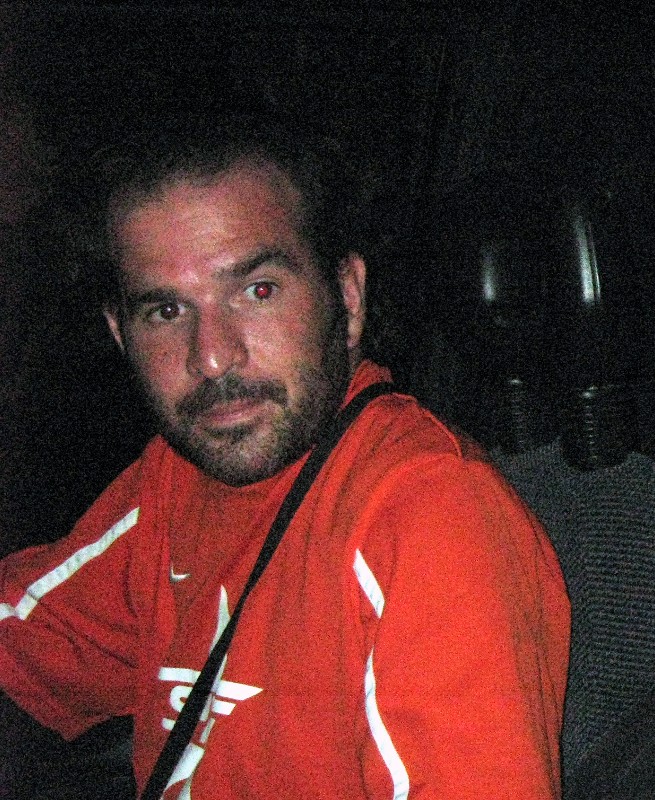 See you in August! ...OR follow Jonathan at his website/blog: www.piratejonnyandthedoc.com |
| On Thursday, just days
after we had an extremely unsuccessful experience at the Aquarium with
my family, Peter and I both left campus at 4 pm, and Peter suggested we
try snorkeling there again. It was a fantastic suggestion, as the
water was calm and clear...and we found more schooling fish there than
we've probably ever seen - even in Hawaii. It was amazing, in
just three feet of water, tens of thousands of small fish streamed by
us. The swift highway of fish seemed so never ending that it was
thrilling and made me giggle into my snorkel. We were enveloped
by four different species of fish, ranging in size from about three
inches to six inches. Naturally, we left the camera home that day
since we had such a late start...but you never know just what you'll
find! Friday, we returned to the Aquarium to see if some of the fish were still spending time in the shallows. Sure enough, we found that quite a few of them were still there. 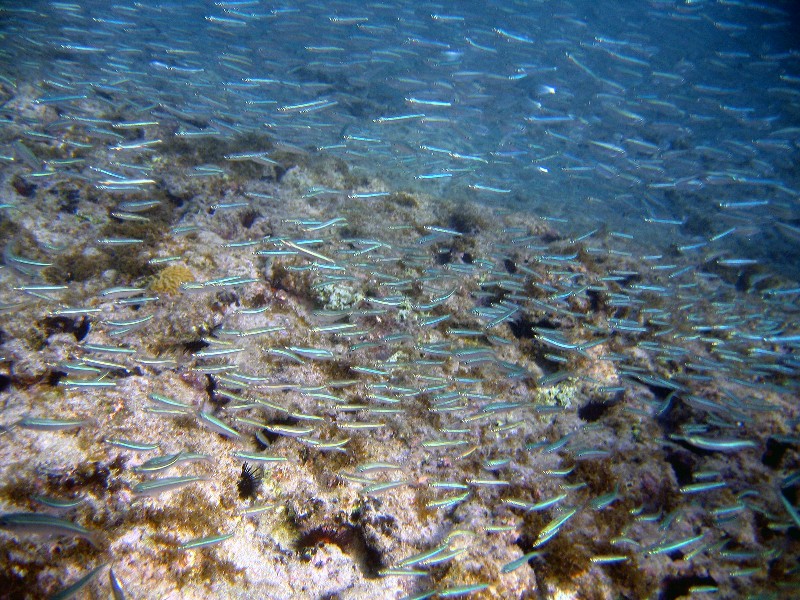 The littler guys. 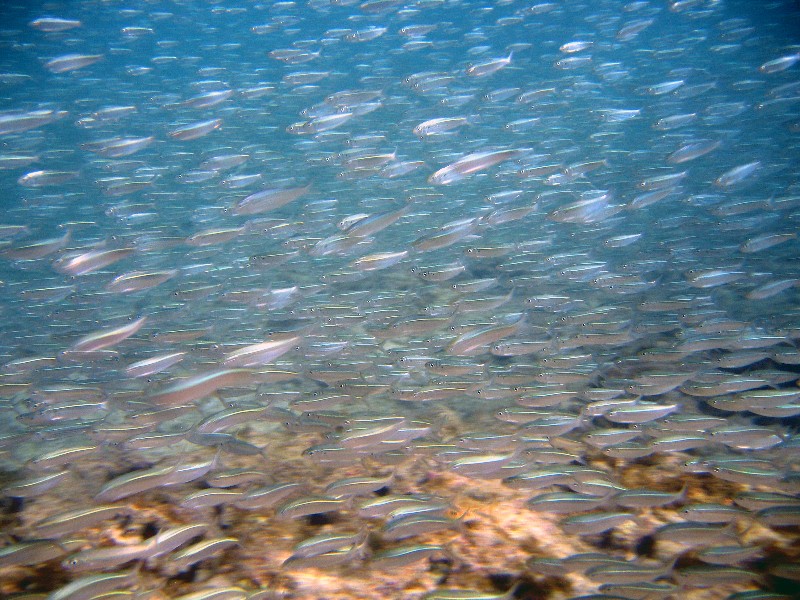 Bigger fishes. You can see how quickly all these fish are streaming past - on all sides - by how out of focus most of them are. 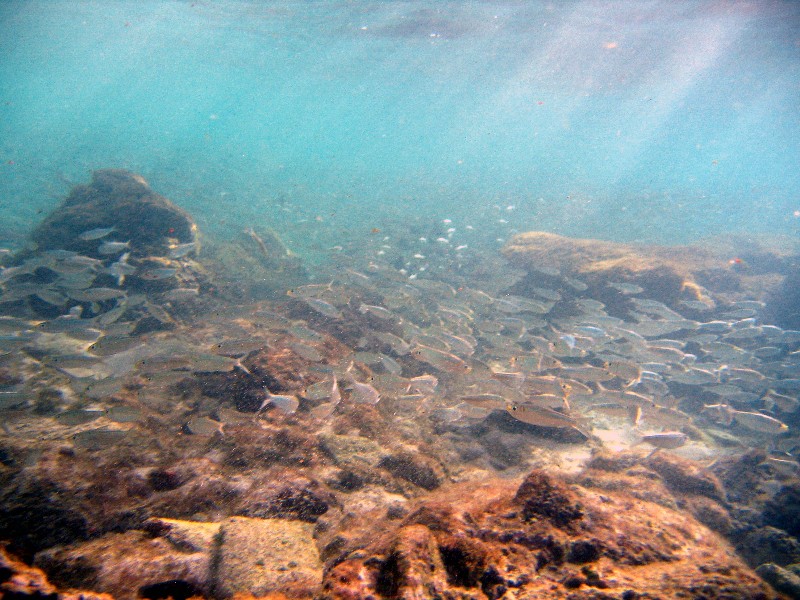 I believe these were the largest schooling fish we saw. In the photo above, you can see that the water is shallow, and here, all the fish have settled to the bottom. The distance looks speckled and grey all those speckles are individual fish! 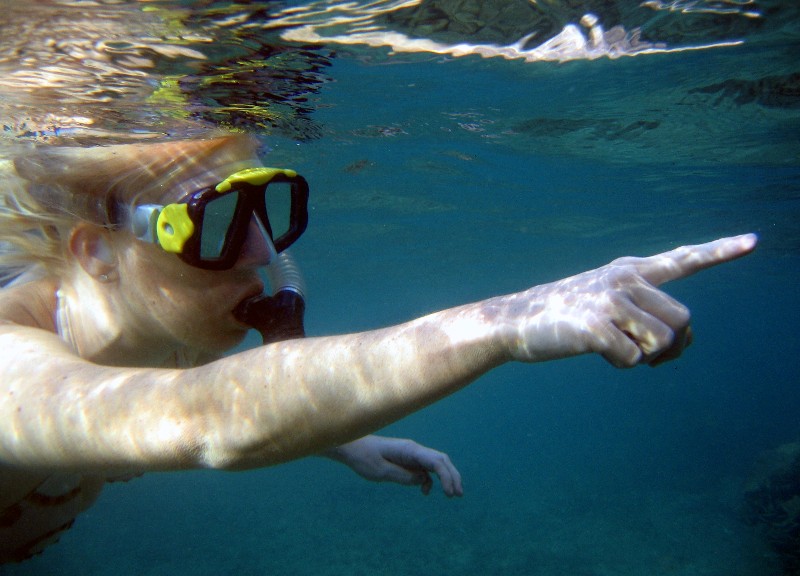 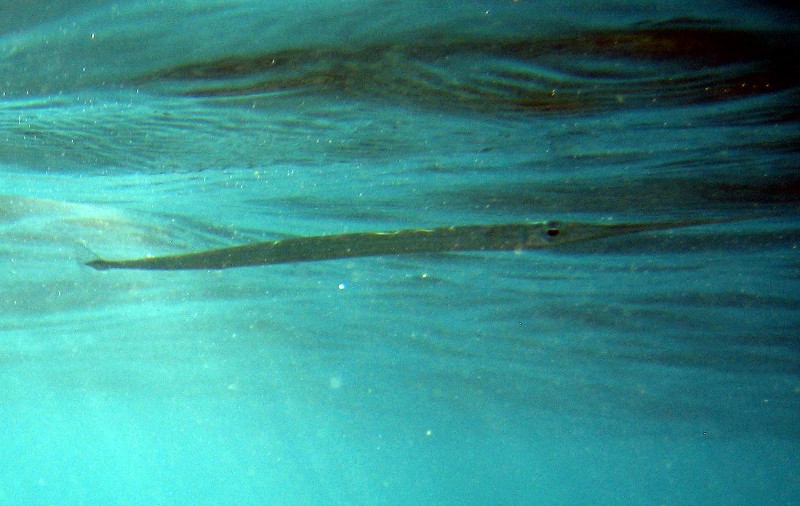 I enjoyed being still and watching all the fish around me. I found that there were a number of small needle fish hovering around the schools, cruising impossibly close to the surface of the water, darting down periodically to gobble down passing fish. These fish were about a foot long, and they seem pencil thin. They blend in so marvelously with the shimmering surface of the sea that they are difficult to spot and track. In fact, it took a bit of manipulating to get the photo to reveal the fish above, as the original image just looks like shades of blue. People often marvel at the camouflage tactics of animals that keep still and manage to blend into their environments, but their costumes are useless when they find the need to move. These creatures somehow manage to beautifully camouflage themselves against a constantly changing background, whilst they themselves are moving. Miraculous! I have to admit that I've been fascinated by needlenoses ever since my mother caught one off of Montauk when I was a child: it is fantastic to swim with them!  Branching coral and a sea fan. 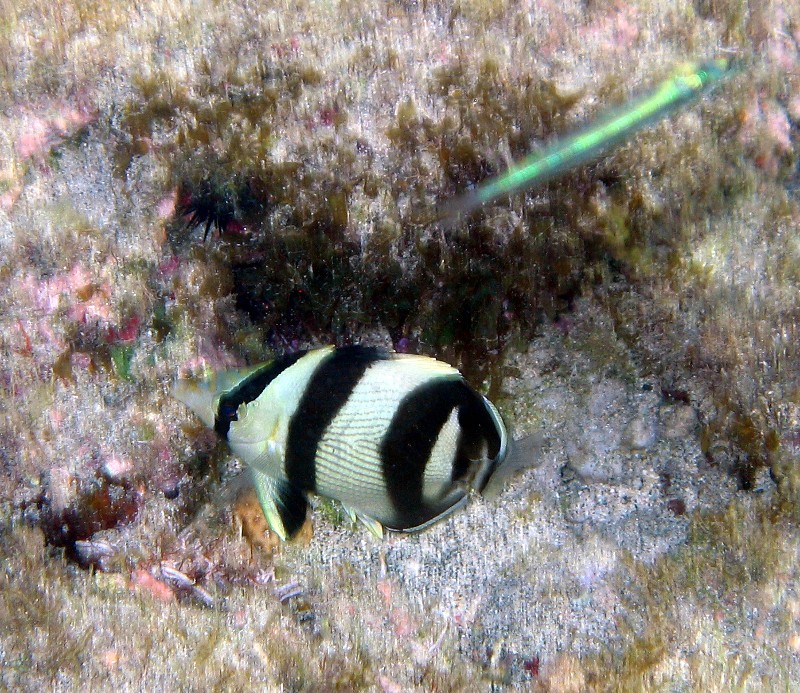  We saw more butterfly fish...and the eels are back! |
Friday night, Britney,
Josh, Peter and I caught up at the Aquarium. I guess we can't get
enough of that place - day or night!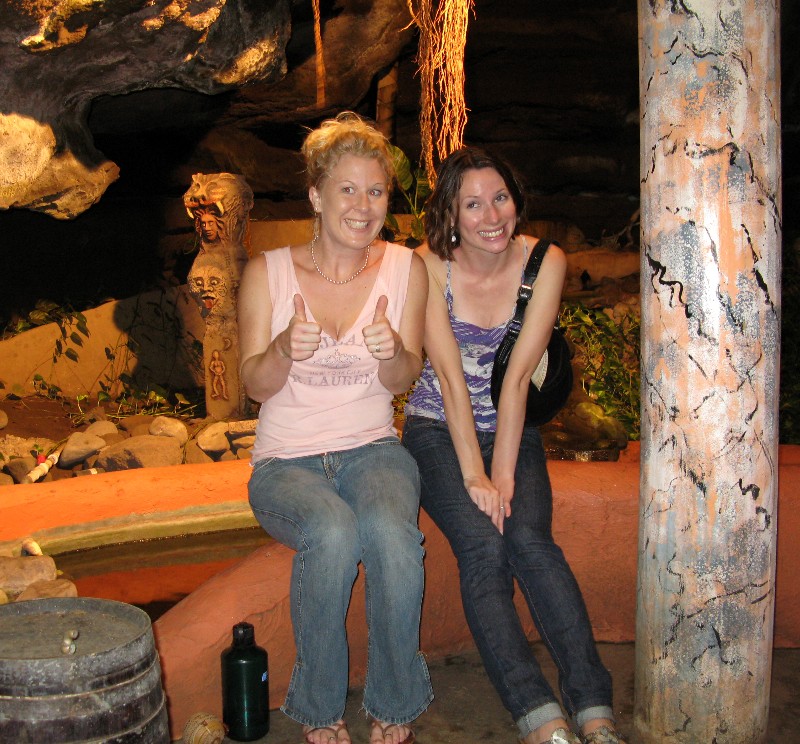 |
On Saturday, Peter and
I joined a group of students heading up to Levera Beach, on the north
side of the island, to enjoy the beach in the afternoon and to look for
turtles after dark.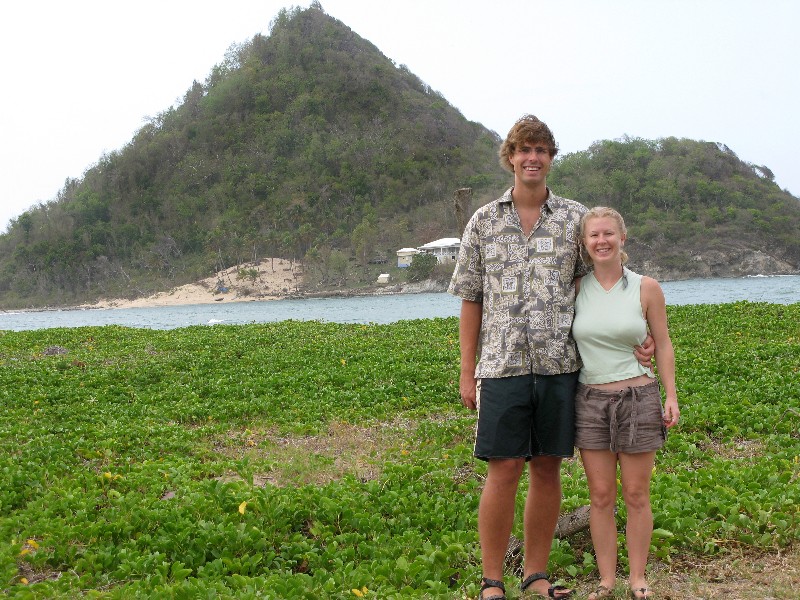 Heather and Peter after we arrived; Sugarloaf Island is in the background. 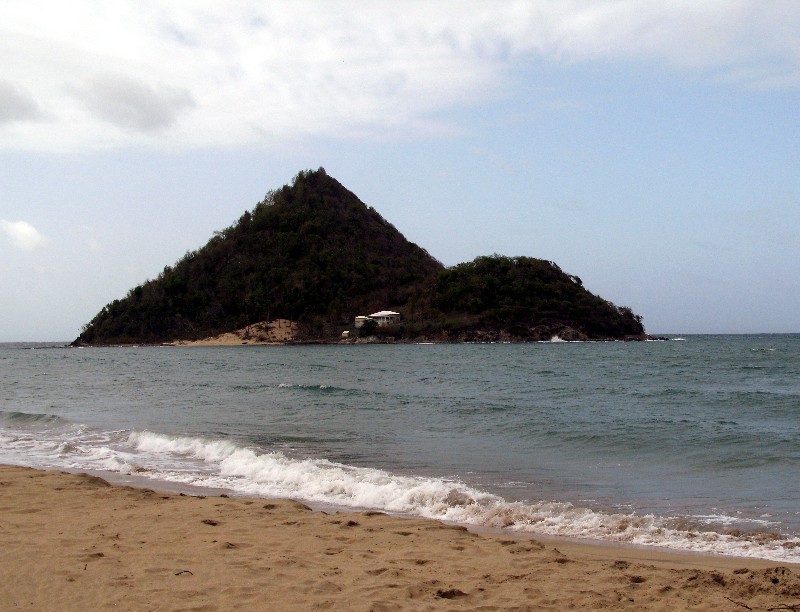  Sugarloaf...and some of the waves along the way! Peter and I brought our snorkel gear, just in case there was any visibility and we might spot some turtles swimming in the water. No luck, as it turns out. We knew this area tends to be more wavy, and less likely to have good visibility, and we found this to be the case today. Soooo, we decided to swim all the way across to Sugarloaf, since there might be a reef and greater visibility on the leeward side of the island. So much for taking it easy! 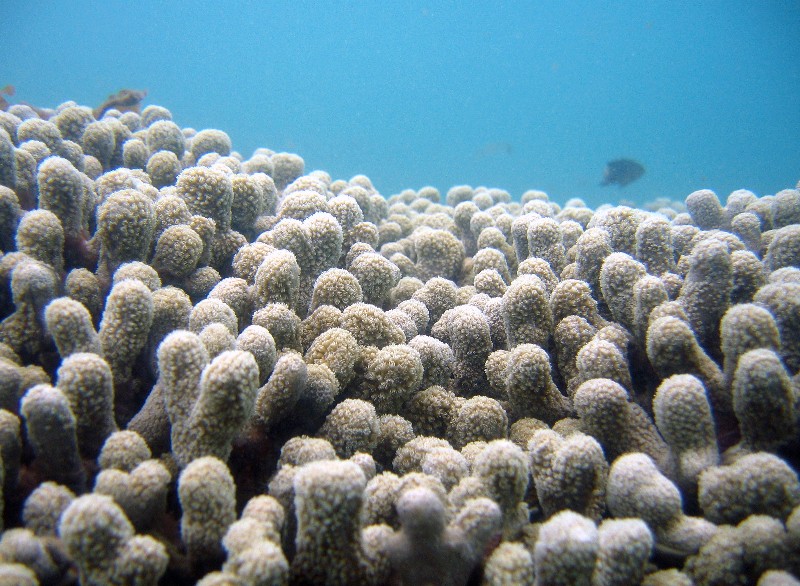 There was indeed a reef on the leeward side of the island. 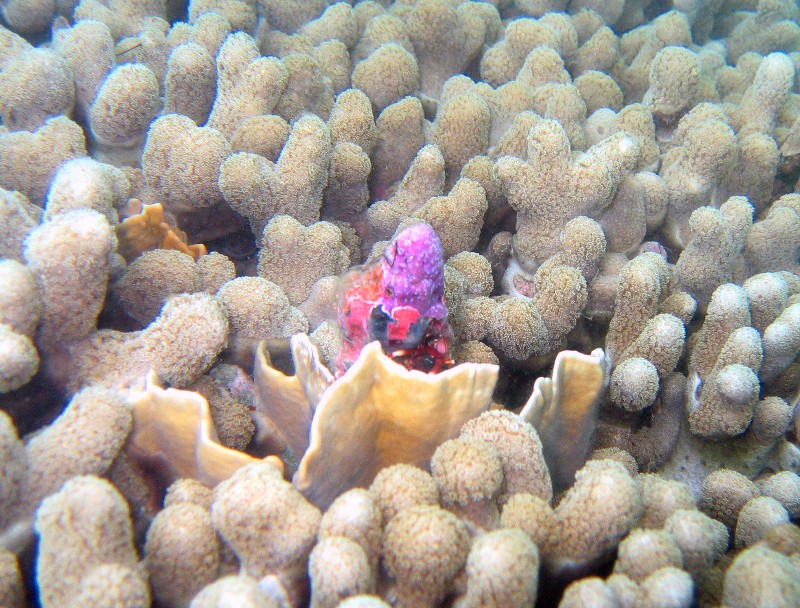 Peter found this great hermit crab in the corals. 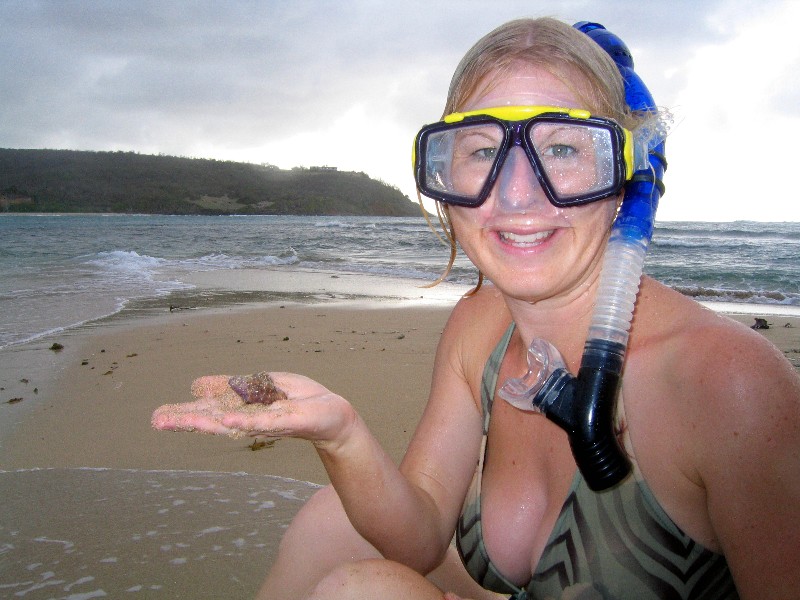 Saying hello to hermie during a rest on the beach. Don't worry, he went right back where he came from! 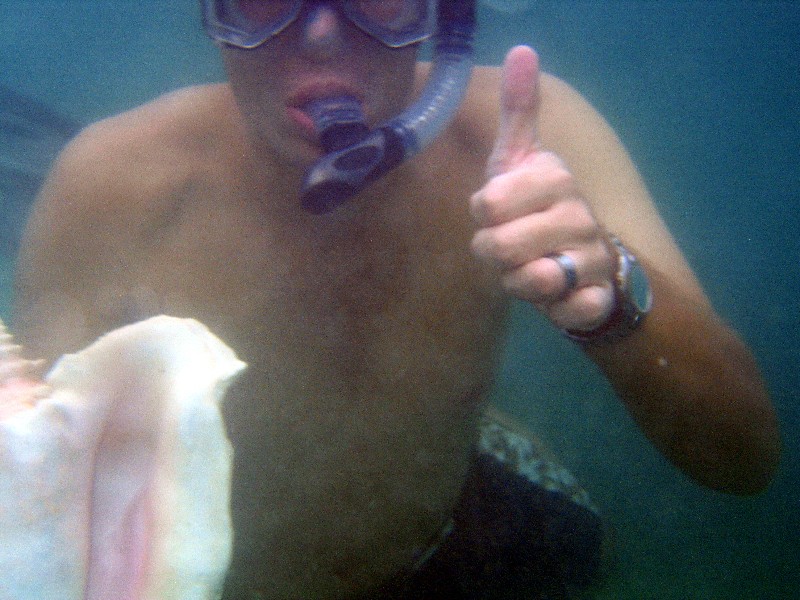 Peter also found a very large and heavy lambie shell, which he lugged all the way back to the main island. The shell was empty, with clear evidence that people had earlier found the conch and eaten it. 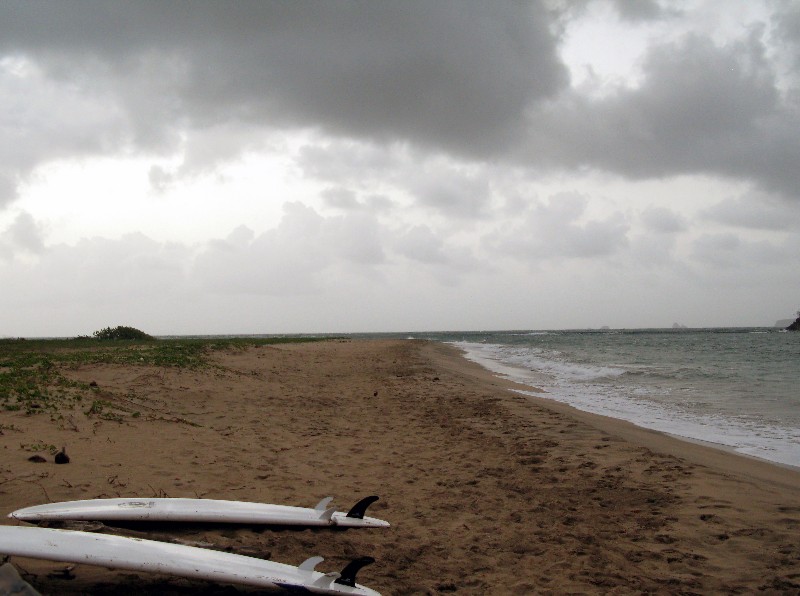 The beach at twilight. At this point, the turtles were only a figment of our imagination; we could only hope we would see one and imagine what they would be like. Peter and I thought we had a pretty good idea what they would be like, as we had snorkeled with many large green turtles in Hawaii a year and a half ago. 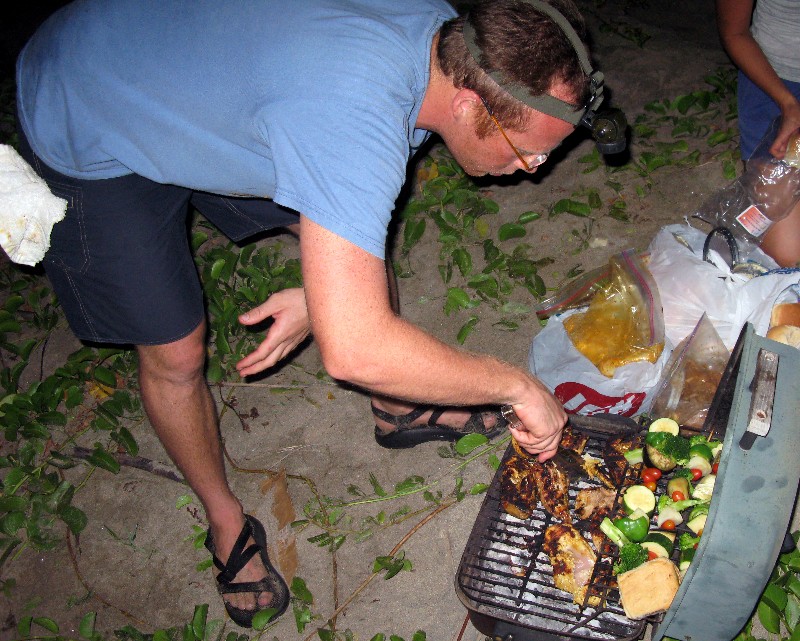 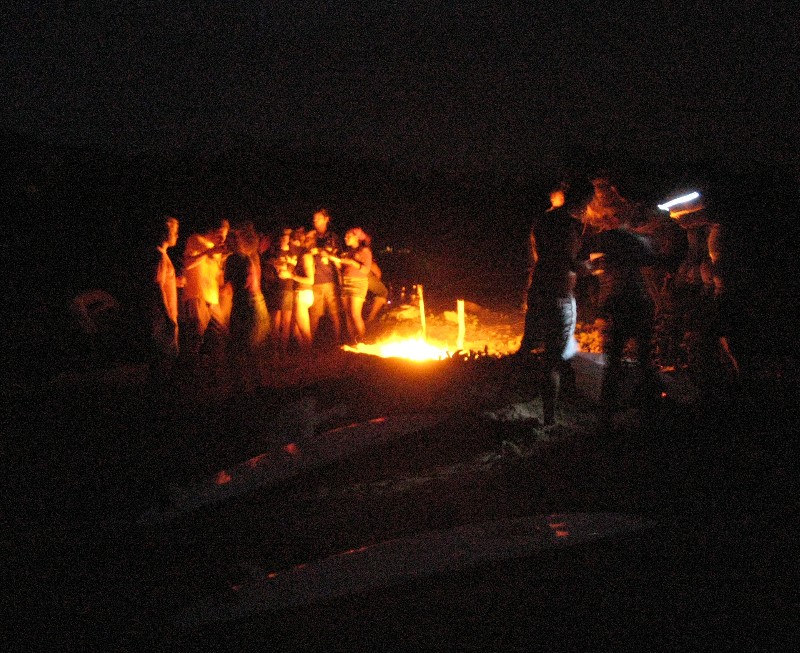 BBQ as the sky got dark. Boy, were we unprepared for what we would experience! We found out that, although Grenada sees a number of turtle species in neighboring waters and on its beaches (like the hawksbill on the region's currency,) Levera seems to host Leatherback turtles almost exclusively. Leatherback turtles are the largest turtles in the world, weighing in from between 500 to 2,000 pounds! These giants are also endangered worldwide. 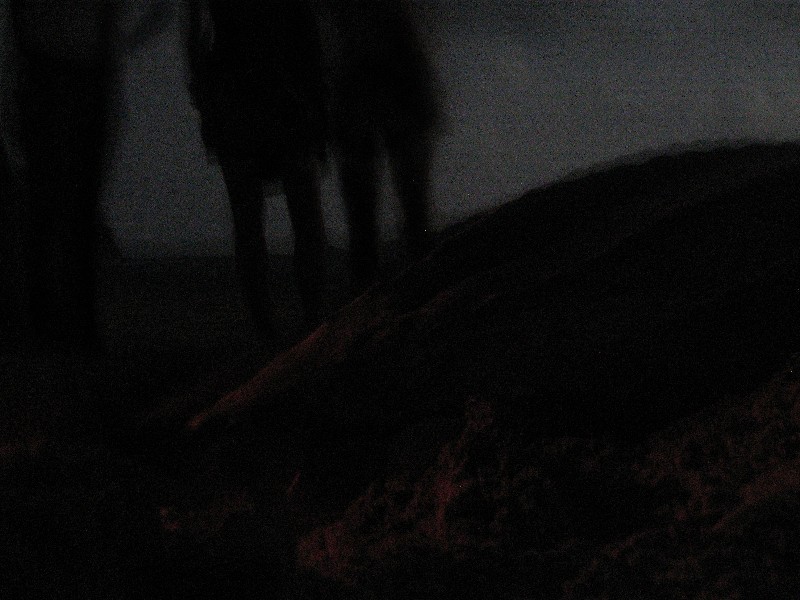 Taking photos was a huge challenge, as Levera Beach is far from any light sources (which is good for the turtles,) and there is no flash photography allowed because sudden bursts of light can dangerously disorient both adults and babies. Peter did a great job given the circumstances. The darkness also means walking on the sand is risky, as one must take care not to step on any babies heading for the water. In the photo above, you might be able to make out the first female we saw; her shell, which is covered with a thin layer of skin, slopes down to the left. Human figures stand in the background to give an idea of scale. 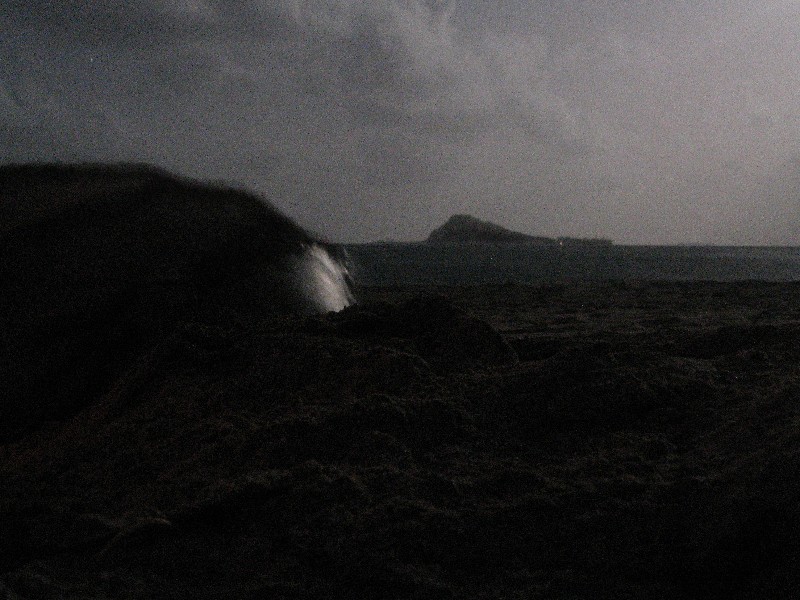 Digging female with an island in the background. People are directed to stay far away from the turtles until they start to dig their hole, as any disturbance might send them back into the sea. Sometimes females make helter skelter tracks and appear to start fake nests before they move on to dig the actual nest. If the adults are scared back into the water before they start digging, females will release their eggs into the ocean, where the babies perish. However, once she is comfortable enough to start to dig the real nest, people can approach from behind and watch her perform her miracle. This is the very back of the female's pointed shell. The red light is not a flame, but a red LED light, which is the safest type of light to shine. You can see her two back flippers stretching downward to dig out the sand. She takes a scoopful of sand from one side by curling her amazingly dexterous flipper inward, and then deftly maneuvers the sand, crane-like, up and to that side of her body, where it is dumped. The opposite back flipper then springs straight up in the air, where any extraneous sand is flung off before the flipper reaches down for another scoop. She goes on in this manner for what seems like about 20-30 minutes, until neither of her flippers can stretch to reach the bottom any longer. The result is inevitably a uniform, very cylindrical, deep hole in which to lay her eggs. The deepest hole we saw was over three feet deep. Conservationists help along the way by cutting any vines that appear in the hole, to prevent the babies from getting caught in them on their journey upwards.  With the hole dug, Momma Turtle starts to lay her eggs: from about 80-100 of them. They come out in spurts, anywhere from one to maybe 8 eggs at a time. The white eggs are soft and covered in mucous. A conservationist typically "catches" the eggs, letting them run through gloved hands so they can be counted. Some of the eggs at the end are tiny and unfertilized. 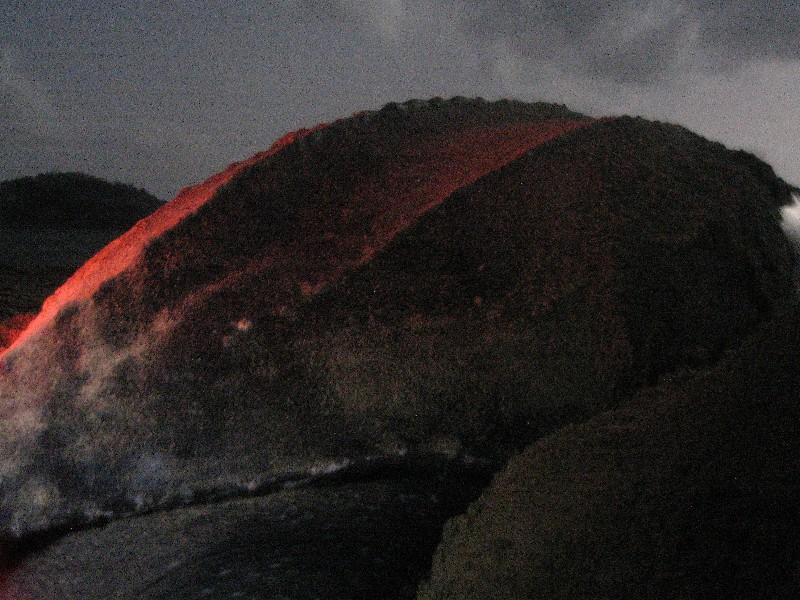 In addition to the egg counter, other conservationists can be simultaneously at work. They hold the flippers far enough apart for the egg counter, some check the turtles' identification tags and/or electronic ID number, others measure the shell, and some keep track of the time each event starts and stops, and someone needs to record all of the data. Conservationists collect data and protect the turtles seven nights a week, six months out of the year, during laying season. The group in Grenada can be found at www.OceanSpirits.org. 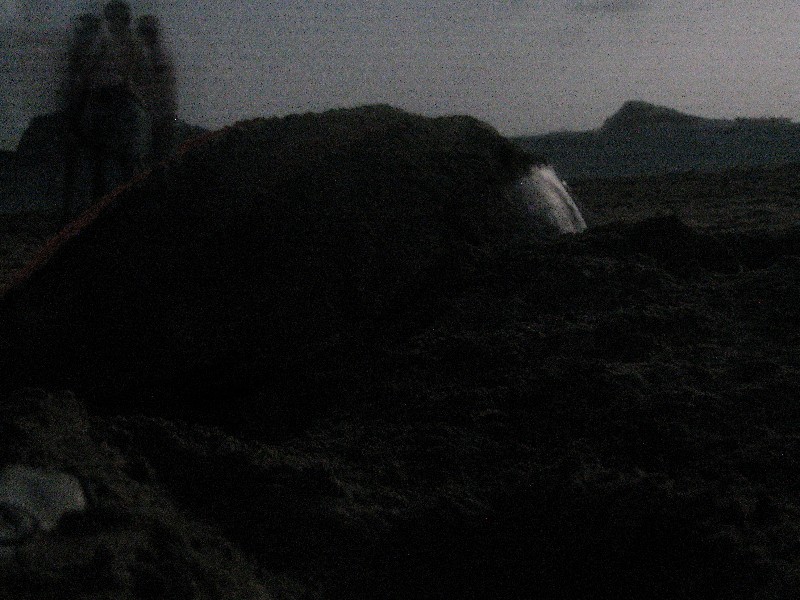 After she is done laying, she fills in the hole, tamping down the sand periodically with those dexterous back flippers. As she is digging or laying or concealing, sometimes a female will stop for a moment to let out a large, audible sigh. 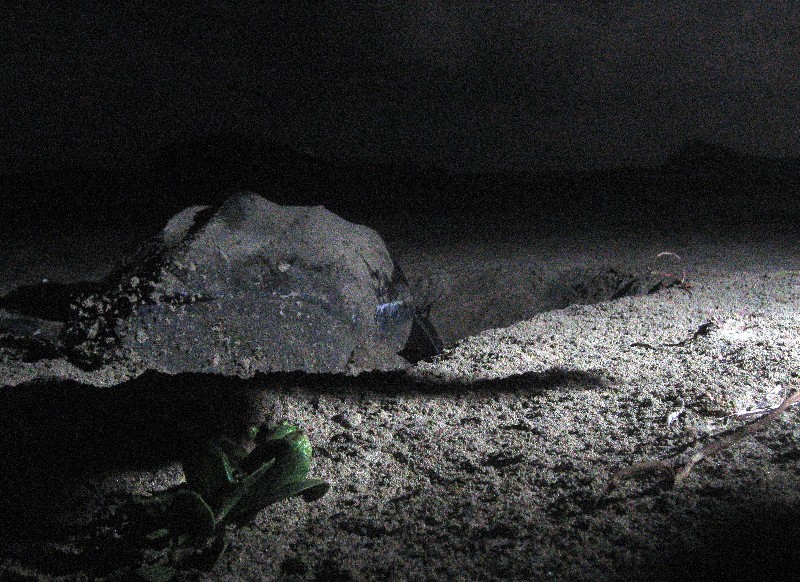 After the hole is filled in, she uses her front flippers to throw sand all over the location. Females often seem to work in a circular motion, sometimes leaving herself elevated on a plateau of sand: as she flings sand she digs a pit all around her. Females can throw sand quite a ways, and in random patterns, apparently to camouflage the actual nest site. When she is satisfied that she has concealed the area and confused any potential predators, she heaves herself back to the sea. In about four hours, we were privileged to see three females lay nests, from start to finish. Peter and I were sorry that we had been part of a very large group, which was a bit overwhelming for us and too much for the conservationists to manage. We also learned many sad facts that night. Grenadians poach the eggs and young of Leatherbacks, and they even kill adult females laying eggs for meat. Just last week, the conservationists recovered 45 eggs from a poacher and put them back into a human-made nest. Moreover, the government is selling the (formerly nationally preserved) land all around the beach for development. Decisions made about how the development will proceed may determine the fate of Leatherbacks in Grenada and impact the world population. Just before we left, we were infused with hope and thrilled to see two tiny babies, the last of a nest to emerge. They came out of the sand and start flip-flopping toward the water. Sometimes they turn upside down in footprints, and a helpful human turns them right-side up. Soon enough, they reach the sea and embark upon an amazing journey. It is impossible to think that these tiny creatures can make it past the waves! Fortunately, they somehow overcome the power of the ocean and hopefully, many of them will return to this very beach with babies of their own! |
| Back to Grenada Home Page |
| June 4 - June 10, 2007 |
| Contact Us |